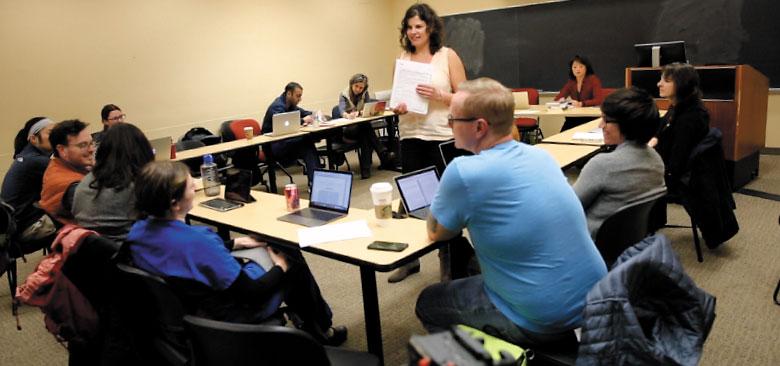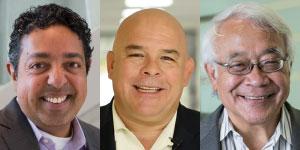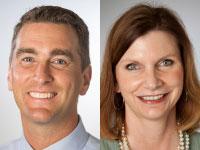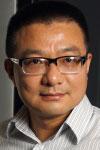
Elena Flowers teaches a genomics class at the UCSF School of Nursing (photo by Elisabeth Fall).
What Clinicians Need to Know About Genomic Testing
On April 6, the personal genomics company 23andMe received authorization from the Food and Drug Administration (FDA) to offer health risk tests directly to consumers for 10 diseases or conditions, including Parkinson’s and late-onset Alzheimer’s. This was more than a triumph for a high-profile business entity; many hope results from these types of tests can help individuals choose healthier lifestyles and better inform their discussions with health care professionals.
It’s not clear, however, whether health care professionals are prepared to offer reliable counseling about the results, much less cope with the ethical and practical questions surrounding such counseling. Elena Flowers argues that it’s time to get prepared.
The director of the Genomics Minor at UC San Francisco School of Nursing and a genomics researcher herself, Flowers is among those who believe advanced practice nurses and their health care colleagues will face increasing numbers of patients with questions resulting from direct-to-consumer (DTC) genomic tests. Determined to spark dialogue among her UCSF colleagues about how best to prepare the health care workforce, Flowers had her entire genome sequenced in early 2017, so she could bring firsthand experience to these discussions and to her students.
The Value of Sequencing
Setting aside for the moment where the sequencing is done, Flowers and many other UCSF experts believe sequencing – whether full genome, whole exome or subsets thereof – has significant value for both clinical care and research, depending on whether the sequencing is done on patients with known medical conditions or on healthy individuals, as is often the case with DTC companies. That distinction, says Flowers, is important for her advanced practice nursing students to understand.
“The value for getting sequenced is clear-cut in many medical cases,” says Atul Butte, who directs the UCSF Institute for Computational Health Sciences, which is building the infrastructure to integrate and analyze a broad array of patient information, including both genomic information and medical records, across the UC Health system. Having a genomic profile for a patient in the context of other important clinical data can help guide decision making in ways that have not been available in the past. This is already the case, for example, with some cancers, as well as in the way sequencing offers insights into how individuals or members of a particular ethnic group will respond to certain medications.
 From left: Atul Butte, Esteban Burchard, Keith Yamamoto “Pharmacogenomics is the low-hanging fruit in precision medicine,” says Esteban Burchard, a pulmonologist and researcher at the UCSF School of Medicine and UCSF School of Pharmacy and a member of the Advisory Committee to the Precision Medicine Initiative, a research project created by former President Barack Obama. “For example, because genetics is the strongest predictor of drug response to the most commonly used medication for asthma, we can do rapid genotyping and make better treatment decisions.”
From left: Atul Butte, Esteban Burchard, Keith Yamamoto “Pharmacogenomics is the low-hanging fruit in precision medicine,” says Esteban Burchard, a pulmonologist and researcher at the UCSF School of Medicine and UCSF School of Pharmacy and a member of the Advisory Committee to the Precision Medicine Initiative, a research project created by former President Barack Obama. “For example, because genetics is the strongest predictor of drug response to the most commonly used medication for asthma, we can do rapid genotyping and make better treatment decisions.”
Yet to varying degrees, many UCSF experts voice concerns that aggressive marketing of DTC genomic tests to healthy individuals could cause widespread misunderstanding of what the results actually convey at this point. The experts worry that few consumers or providers will remember or understand that except in rare cases of a highly penetrant gene mutation, genomics is only one important piece of a much larger precision medicine puzzle.
“In precision medicine, genomic information must be integrated with many other parameters – other ‘omics’ as well as medical records and social, behavioral and environmental determinants – in ways that reveal what each contribution is and why it matters,” says Keith Yamamoto, vice chancellor of Science Policy and Strategy and director of UCSF Precision Medicine. “We are developing ways to stack different data types together to find correlations, interactions and patterns that create hypotheses for basic science, and change diagnoses and treatments in the clinic. We are making great progress, but we are far from done.”
The Need for Providers to Convey Context
For health care professionals, these types of considerations make counseling patients about genomic testing a considerable challenge. Partly, this is due to the fact that many providers lack a solid grounding in recent advances in a fast-changing field. It’s also because during a short appointment in which many things need to be addressed, providers may now also have to confront frightened patients who misunderstand the predictive power of the genomic screens.
 Julie Harris-Wai (left) and Catherine Bliss “Individuals may believe the results of these tests are deterministic, when they are really just probabilities of probabilities. If it’s not explained in the appropriate way, it can get very confusing,” says Julie Harris-Wai, a researcher in the School’s Institute for Health & Aging and the associate director of the Center for Transdisciplinary ELSI (Ethical, Legal and Social Implications) Research in Translational Genomics, a joint project of Kaiser Permanente, UCSF and UC Hastings College of the Law.
Julie Harris-Wai (left) and Catherine Bliss “Individuals may believe the results of these tests are deterministic, when they are really just probabilities of probabilities. If it’s not explained in the appropriate way, it can get very confusing,” says Julie Harris-Wai, a researcher in the School’s Institute for Health & Aging and the associate director of the Center for Transdisciplinary ELSI (Ethical, Legal and Social Implications) Research in Translational Genomics, a joint project of Kaiser Permanente, UCSF and UC Hastings College of the Law.
Catherine Bliss, a sociologist who teaches in the School’s Department of Social and Behavioral Sciences and author of an award-winning book – Race Decoded: The Genomic Fight for Social Justice – says, “The personal genomics industry is barely regulated, and people are not necessarily receiving information tailored to their situation, so counseling from a medical or population geneticist is essential – and nobody does that.”
 Kord Kober (left) and Lynda Mackin “All the more reason to be prepared to engage in this process in a meaningful and useful way as it unfolds,” says Flowers, who is not only bringing her experience and expertise to the Genomics Minor, but is also part of a team – with fellow faculty members Kord Kober and Lynda Mackin – that is developing and integrating a new genomics course into the core master’s program at the School of Nursing.
Kord Kober (left) and Lynda Mackin “All the more reason to be prepared to engage in this process in a meaningful and useful way as it unfolds,” says Flowers, who is not only bringing her experience and expertise to the Genomics Minor, but is also part of a team – with fellow faculty members Kord Kober and Lynda Mackin – that is developing and integrating a new genomics course into the core master’s program at the School of Nursing.
At the very least, she believes, it’s important for providers to know how to quickly put testing results in context. “It’s easy for these [DTC] companies to glorify what kinds of conclusions can be made, but providers need to have a grasp on the limitations of sequencing,” she says. “Even if they can’t explicate on and on, conveying the limitations is a base level of counseling.”
Bioethicist Barbara Koenig, who leads UCSF’s bioethics team, co-directs the Center for Transdisciplinary ELSI Research in Translational Genomics and is also a faculty member in the School’s Institute for Health & Aging, says there are a host of questions surrounding a provider’s role in explaining the results of these tests. They include: What do patients want to know? Need to know? What if a test reveals something unexpected, for which there is no intervention available? Should family members be consulted? Where should the lines be drawn?
 Barbara Koenig (left) and Monica McLemore That’s why another element of provider preparation needs to be learning how to communicate risk. That understanding comes from fully engaging with the individuals undergoing these types of tests, argues Monica McLemore, an assistant professor at the School and associate director for Community-Engaged Research in the UCSF Preterm Birth Initiative (PTBi).
Barbara Koenig (left) and Monica McLemore That’s why another element of provider preparation needs to be learning how to communicate risk. That understanding comes from fully engaging with the individuals undergoing these types of tests, argues Monica McLemore, an assistant professor at the School and associate director for Community-Engaged Research in the UCSF Preterm Birth Initiative (PTBi).
In the latter role, McLemore co-leads an effort that aims to understand how to communicate – and not overcommunicate – risk, particularly when there is no intervention or cure, as is the case with many of the conditions for which genomic testing can indicate a predisposition.
“The discussion we started with our community advisory board was around identifying the ethical issues and ethical lines in communicating risk,” she says. “Their involvement is essential to finding those lines.”
In close collaboration with these women at high risk for preterm birth, the PTBi leadership and scientific team is co-developing a framework for precisely this type of communication, which McLemore hopes providers will ultimately be able to use flexibly, sensitively and effectively.
Pressuring Providers and the Health Care System
How providers understand findings from genomics testing and communicate risk are primary concerns, but they are hardly the only ones for those trying to prepare the health care workforce. Another is the pressure DTC testing of healthy individuals could bring to bear on providers and an already overburdened health care system.
Koenig, who believes there is enormous value in sequencing people with specific medical conditions and for research purposes, worries that, “Predictive genomic testing on healthy populations has not been demonstrated to have clinical utility. Sequencing healthy people can distract them and their providers from the environmental and social determinants of health.”
Moreover, revealing risks that can’t be acted upon creates what sociologists like Stefan Timmermans at UCLA have called “patients-in-waiting,” who live in an ambiguous state while they anticipate when and if symptoms will occur. Perhaps equally important, both Koenig and Harris-Wai note that despite the widely publicized idea that the cost of genomic testing is coming down, the true costs come from the counseling, interpretation and follow-up tests. Those costs, which can be substantial, as well as demands on provider time, drain much-needed resources from things that have a more immediate and lasting impact on people’s health. Therefore, providers may need training in how to create and convey the proper balance.
Needed: A Basic Understanding of Big Data and Bioinformatics
Despite the many concerns and challenges, Flowers believes that DTC companies – with a budget and talent for marketing that government struggles to match – have played an important role in exciting consumers about genomic testing and overcoming their many fears. The resulting rush to test can benefit a few patients in the short term, but can also catalyze research efforts aimed at gleaning more reliable and actionable information.
That, in turn, might address some of the health system resource concerns, because amassing data and developing advanced analytical capabilities are central to the pursuit of true precision medicine, says Yamamoto. He points to the efforts of Butte at UCSF and to the National Institutes of Health (NIH)’s All of Us and Big Data to Knowledge (BD2K) initiatives, both of which are trying to create information systems that can ultimately deliver trustworthy insights for providers and individuals with one or two clicks of a mouse.
“But we’re not there yet, which puts us in an odd state of limbo,” says Flowers. And this limbo raises another challenge for providers. If they are to counsel their patients on whether or not to undergo genomic testing at all, particularly DTC genomic testing, they must understand the current limitations of the data itself, as well as the limits of our current technology to accurately interpret the data.
Butte says that the accuracy of full genome sequencing is getting better, but is not yet what he calls “medical grade.” Most of the labs offering testing are subject to federal regulatory standards called the Clinical Laboratory Improvement Amendments, but these standards don’t address the clinical validity or utility of genetic tests – only how the tests are performed, the qualifications of laboratory personnel, and quality control and testing procedures for each laboratory.
Providers need to understand this in counseling their patients, as well as some of the racial biases in the genomics data. “At this point, the reference maps are heavily weighted toward European populations, which means even the ancestral information these groups offer is questionable for people looking to confirm their racial background,” says Bliss.
Burchard believes this imbalance can compromise the ability to use genomics as powerfully as we might, pointing to the way clopidogrel, a commonly used drug for heart attacks, is not properly activated in large segments of the Asian population. In a November 2016 PLOS Medicine commentary, Burchard noted: “In the face of our ongoing Genomic Revolution, the percentage of research participants with non-European ancestry in NIH-supported modern genetic studies has only increased from 4% in 2009 to 6% in 2016.” His solution is to ramp up sequencing for minority populations, but in settings where the data can be shared among researchers and is protected by federal standards.
Yet even if sequencing achieves widespread medical-grade accuracy and addresses concerns about racial bias, there is still the challenge that Butte and BD2K are trying to address of bringing genomic data together with data from medical records and social and environmental factors in a system that can make sense of all the complex interactions.
“It’s much easier to figure out the DNA sequence of a patient than to figure out what we’re doing and measuring in all the rest of medicine for a patient,” says Butte. “Our big data problem is figuring out the medical record side. We have the raw pieces – but now we need to synthesize and put a story together for the patient.”
 Xiao Hu “We have to integrate that middle layer,” says Xiao Hu, who in 2013 became one of the first biomedical engineers in the country on faculty at a school of nursing. “The encouraging thing is that we have more and more data – gene editing, for example, allows us to observe and establish causal relationships – and this can lead to the better modeling necessary for the next steps.”
Xiao Hu “We have to integrate that middle layer,” says Xiao Hu, who in 2013 became one of the first biomedical engineers in the country on faculty at a school of nursing. “The encouraging thing is that we have more and more data – gene editing, for example, allows us to observe and establish causal relationships – and this can lead to the better modeling necessary for the next steps.”
Of course, all of this – and perhaps especially the gene editing – raises social and ethical questions that are beyond the scope of this article. One, however, is worth mentioning because it plays into what providers need to know in counseling their patients about whether to undergo DTC genomic testing: concerns about the privacy and security of the data.
These concerns have largely focused on whether health insurers or employers will use genetic information to discriminate in various ways. The Genetic Information Nondiscrimination Act (GINA) of 2008 bars this type of use, but a proposed new bill – the Preserving Employee Wellness Programs Act – could allow employers to legally request information from personal genetics tests or family medical histories. In addition, GINA does not currently prevent other types of insurers, such as life or disability insurers, from demanding this information if an individual has it.
“I worry too that not all company materials are clear about how they are using the information they gather,” says Harris-Wai. “People [doing sequencing with private companies] don’t understand their data is being shared with researchers and other organizations, that they are in a biobank without the same protections that a UCSF would afford them because of the protections of the Common Rule.” The Common Rule is the Federal Policy for the Protection of Human Subjects, the baseline standard of ethics for the treatment of human subjects in any government-funded research in the United States.
Incorporating the Knowns and Unknowns into Provider Training
 Elena Flowers Flowers says that all of these concerns mean that she is trying to prepare her advanced practice nursing students for a period of uncertainty of unknown duration. “That type of teaching is a real paradigm shift from how education happened 20 years ago,” she says. “It’s very dynamic, and for our students who have been in practice a long time and learned a relatively stable set of facts and methods, it can feel disorienting.”
Elena Flowers Flowers says that all of these concerns mean that she is trying to prepare her advanced practice nursing students for a period of uncertainty of unknown duration. “That type of teaching is a real paradigm shift from how education happened 20 years ago,” she says. “It’s very dynamic, and for our students who have been in practice a long time and learned a relatively stable set of facts and methods, it can feel disorienting.”
They need to be prepared, she says, not just to provide interpretation of genomic tests, context about the promise and limits of sequencing, and facts about the differences between DTC and testing done in clinical settings, but also to integrate all of this into the holistic thinking that has long been a hallmark of nursing education. She mentions the example of her own collaborative work, which involves whether she can incorporate epigenetic biomarkers into machine-based learning algorithms in smartphone applications to individualize behavior change incentives for patients with type 2 diabetes.
“Gene panels are important in this regard because the effect size [of one gene] for chronic disease is very small, but if we pull together 50 different genes, we can magnify the signal. But we’re still only addressing biology, not taking into account environmental and behavioral factors. These are also the types of things I want my students to understand and be prepared to adapt to,” says Flowers.
She adds that in counseling about DTC testing, providers might also point out the research benefits of being sequenced. “It makes sense that sequencing is most useful at this point at a population health level,” she says. “Historically, research has usually been done this way. In the majority of research studies, participants don’t receive immediately useful individual results, so sequencing is following this historical model.”
Some would argue, however, that while more sequencing is essential to accelerating the ability of researchers to deliver the promised clinical benefits of precision medicine, it is best done in situations that deliver the results to large, shared databases, such as what is coming together through the Global Alliance for Genomics and Health. Hence, the preference of many in the health professions for sequencing of healthy patients to be done in the academic medicine settings that typically participate in these collectives. In contrast, many DTC companies do not share their information, though that may change as the incentives to share increase.
The Train Has Left the Station
DTC testing raises complicated questions with no easy answers. What providers need to know and how to train them appropriately is only one of the issues that concern those deeply immersed in precision medicine.
As to whether we should have DTC testing at all, Flowers and many others across UCSF accept that that train has left the station. What’s important now is that teams of committed people come together to figure out the best way forward. Getting her own genome sequenced by a private company, Flowers feels, was a surprisingly important part of that process.
“I’ve become more impassioned and much more reflective, because I’m committing so much of my thought and energy to this, and it’s connected me with so many different people on campus,” she says. “It’s been impactful in ways that would have been impossible to anticipate when I started this.”



